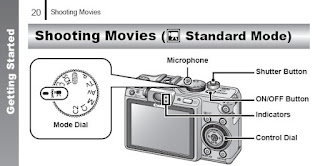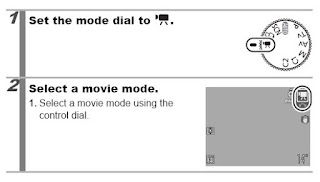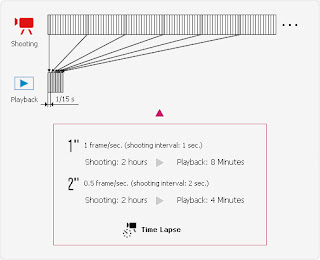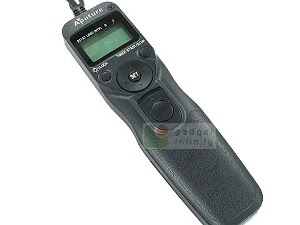Well mostly because sometimes there are camera functions that could be useful on some situations and you never thought your camera could make them just because you haven't read the manual once.
Normally and by habit I read all instruction manuals at least one time, this would give me the opportunity to better know the camera and also find out what options I have that could help me out on some specific situations.
Everyone, by now, knows that all cameras have Aperture and Shutter Speed modes and normally the point and shoots you just bought them for what they are named for Point-And-Shoot so why bother reading the instructions manual.
But what about an Intervalometer or Time Lapse shooting?
Hey Rui, what the heck is Time Lapse shooting, you may ask?
Let's take a brief moment in time to picture how this all thing started out.
Movies were born when Auguste and Louis Lumiere (and ultimately Thomas Edison) projected a series of still photos in rapid succession, causing the viewer to perceive motion where there was none.
Matching the projector's speed with the speed of the camera made the motion lifelike. Under cranking (running the camera slowly) and over cranking (running the camera faster than the projector) caused a film to appear faster or slower than reality. It wasn't long after the invention of motion pictures that camera operators and directors intentionally ran the camera faster or slower than normal to create special effects.
Time-lapse photography is a variation on this. With time-lapse photography, it's possible to compress time into short periods, making days or weeks pass by in seconds.
Hackneyed examples include flowers unfolding in the sun and clouds passing across scenic horizons. But cobble together a cheap digital camera, a 70,00 euros or less remote timer, and a motorcycle battery, and you've got the basics of a system that can go far beyond clichés.
So, the tip for today is this cool feature that is buried under one of the Canon Powershot G9 option menus.
First go get the instructions manual and let's begin, but if you couldn't find it just follow along.

Turn to page 20 to the Shooting Movies mode and start reading... on the camera you can turn the mode dial to Movie.

Now select a movie mode called Time Lapse. It's the one with a Camera and Clock symbol.

If you press the Func./Set button on the right while choosing this mode you will have the option to choose AWB, My Colors, ND Filter and Interval Time for 1" or 2".

On page 107 you can see how you can change the shooting interval. You are limited to 1" or 2" this depends on how fast you will want your photos to be taken.

Select a shooting interval (1 or 2 sec.) to have a single frame shot at that interval. (Sound cannot be recorded in this mode.) You can record events from a fixed perspective, such as the spectacle of a flower budding over time, or view changing elements in a short period.

This table shows you what are the recording pixels and frame rate as well as Maximum clip length that in the case of the Canon Powershot G9 you are limited to the time that the battery hold before it dies out.
Here is an example I've done so you could see of what you can do with this great feature hidden within your Canon Powershot G9.
I made this picture movie with my Canon Powershot G9 using the above mentioned menu option and used the 2" until the battery run out on me it took almost 2 hours.
One the Canon Powershot G9 you don't have to compile all the pictures you took you simply have to let it do it's thing and afterwards maybe add some music, like I did, and export it to web view profile in QuickTime Pro or other video editor software.
On the Canon Powershot G9 there are several limitations to this feature but I think you can get some cool video shots just before the battery dies.
My previous Canon Powershot G6 add and Intervalometer that allowed me to choose how many pictures it will be taken during a set period of time, then I just needed to mount them together in order to get the same video effect. Took me more time to get the video together instead of this already made on the Canon Powershot G9 but the results were almost the same.
One thing that is more critical is that you are limited to the battery life, since you could not have the camera plugged into external power (at least that I know of, if you know how just drop me a line), so if you use the Time Lapse feature make sure you will have a fresh battery.
Another thing is that you will have no control whatsoever over the exposure values of the camera and as you can see, at the end, on the photo video I made I was getting a lot of noise on because the camera adjusted the exposure and ISO automatically.
Last but not least it's not possible to make a drag shutter speed so that people could be dragged over the exposures and this is due to the fact that you are limited to 1" or 2" frame rate.
I used on my video 2" and as you can see the clouds, birds and trees are moving very fast I then tested it, on another day, with 1" and it looked more soft the transitions so I think if the clouds are moving fast on the day then you should use 1" frame rate.
You can take a look at some more examples of Canon Powershot G9 Time Lapse in here.
And because Time Lapse is not only available on the Canon Powershot G9 you can also take some great Time Lapse pictures with your own DSLR and build the video later, but for that you will need one of the above Intervalometers or Timer Remotes.

Gadget Infinity has them also available for several cameras at a low price. Mine is from them and I do prefer it to Canon one since it has more options and are easy to program besides it's cheaper.

Photographer Zach Wise has an excellent DSLR Time-Lapse in-depth video tutorial.
Here are some great online pages for some more DSLR Time Lapse follow up and how to:
- Time Lapse Tutorial
- Time Lapse Photography - Using a Still Camera and Timer
- Time Lapse Photography - With a Web Cam
- Ultimate Guide to Time Lapse Photography
I'm leaving you with some examples of Time Lapse photography.
You can create amazing small movies of your sessions like the ones from the Martin Scorsese Time Lapse Photo Shoot even if you do not own a video camera:
or maybe create something more elaborated like this:
This is a new way of taking your photography to the next level. I'm pretty sure you have already seen it somewhere but never thought your Canon Powershot G9 could do it ;)
I know that a lot of agencies are asking for this kind of movies and has a big example you have the successful commercial add of Sprint.
Here it is in case you haven't seen it yet.
Hope you enjoy this hidden feature and with it make a lot of cool stuff.
4 comments:
I read a post at the Instructables site that shows you how to use a TI-83 Calculator as an Intervalometer for you Canon EOS cameras.
I did the same thing only during a 14 hour period. It's in Barcelona with a d200 set to take a photo ever 5 minutes.
http://www.youtube.com/watch?v=CMnxX273pKI
Thanks Rui. I liked it so much that I had to make one.
abraços
cá vai: http://fotoben.blogspot.com/2008/03/depois-de-ler-um-post-do-rui-leal-sobre.html
Awesome tutorial - thanks. One question, though. Have you ever encountered problems loading time-lapse videos on YouTube? (I see that you did get it to work.) I have no problem posting regular video from the G9, but it refuses to process the time lapse videos, which are shorter than the others. Any tips would be appreciated. I'm on a Mac, if that makes any difference.
-benito
Post a Comment